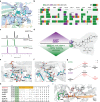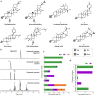Characterization and structure-based protein engineering of a regiospecific saponin acetyltransferase from Astragalus membranaceus
- PMID: 37749089
- PMCID: PMC10519980
- DOI: 10.1038/s41467-023-41599-7
Characterization and structure-based protein engineering of a regiospecific saponin acetyltransferase from Astragalus membranaceus
Abstract
Acetylation contributes to the bioactivity of numerous medicinally important natural products. However, little is known about the acetylation on sugar moieties. Here we report a saponin acetyltransferase from Astragalus membranaceus. AmAT7-3 is discovered through a stepwise gene mining approach and characterized as the xylose C3'/C4'-O-acetyltransferse of astragaloside IV (1). To elucidate its catalytic mechanism, complex crystal structures of AmAT7-3/1 and AmAT7-3A310G/1 are obtained, which reveal a large active pocket decided by a specific sequence AADAG. Combining with QM/MM computation, the regiospecificity of AmAT7-3 is determined by sugar positioning modulated by surrounding amino acids including #A310 and #L290. Furthermore, a small mutant library is built using semi-rational design, where variants A310G and A310W are found to catalyze specific C3'-O and C4'-O acetylation, respectively. AmAT7-3 and its variants are also employed to acetylate other bioactive saponins. This work expands the understanding of saponin acetyltransferases, and provide efficient catalytic tools for saponin acetylation.
© 2023. Springer Nature Limited.
Conflict of interest statement
The authors declare no competing interests.
Figures





Similar articles
-
Functional Characterization and Protein Engineering of a Triterpene 3-/6-/2'-O-Glycosyltransferase Reveal a Conserved Residue Critical for the Regiospecificity.Angew Chem Int Ed Engl. 2022 Feb 14;61(8):e202113587. doi: 10.1002/anie.202113587. Epub 2021 Dec 29. Angew Chem Int Ed Engl. 2022. PMID: 34894044
-
Characterization and protein engineering of glycosyltransferases for the biosynthesis of diverse hepatoprotective cycloartane-type saponins in Astragalus membranaceus.Plant Biotechnol J. 2023 Apr;21(4):698-710. doi: 10.1111/pbi.13983. Epub 2023 Jan 5. Plant Biotechnol J. 2023. PMID: 36529909 Free PMC article.
-
Identification of oxidosqualene cyclases associated with saponin biosynthesis from Astragalus membranaceus reveals a conserved motif important for catalytic function.J Adv Res. 2023 Jan;43:247-257. doi: 10.1016/j.jare.2022.03.014. Epub 2022 Mar 26. J Adv Res. 2023. PMID: 36585112 Free PMC article.
-
Research progress of astragaloside IV in the treatment of atopic diseases.Biomed Pharmacother. 2022 Dec;156:113989. doi: 10.1016/j.biopha.2022.113989. Epub 2022 Nov 8. Biomed Pharmacother. 2022. PMID: 36411656 Review.
-
Astragalus species: Phytochemistry, biological actions and molecular mechanisms underlying their potential neuroprotective effects on neurological diseases.Phytochemistry. 2022 Oct;202:113293. doi: 10.1016/j.phytochem.2022.113293. Epub 2022 Jun 30. Phytochemistry. 2022. PMID: 35780924 Review.
Cited by
-
Comparative genomics provides insights into the biogeographic and biochemical diversity of meliaceous species.Nat Commun. 2025 Mar 17;16(1):2603. doi: 10.1038/s41467-025-57722-9. Nat Commun. 2025. PMID: 40097398 Free PMC article.
-
Shenyuan granules improve cellular senescence through Klotho-mediated p16/p21 signaling pathway in diabetic kidney disease.Front Med (Lausanne). 2025 Jul 31;12:1627412. doi: 10.3389/fmed.2025.1627412. eCollection 2025. Front Med (Lausanne). 2025. PMID: 40823556 Free PMC article.
-
The mechanism of polyphyllin in the treatment of gastric cancer was verified based on network pharmacology and experimental validation.Heliyon. 2024 May 18;10(10):e31452. doi: 10.1016/j.heliyon.2024.e31452. eCollection 2024 May 30. Heliyon. 2024. PMID: 38831826 Free PMC article.
-
Decoding and reprogramming of the biosynthetic networks of mushroom-derived bioactive type II ganoderic acids in yeast.Cell Discov. 2025 Jul 8;11(1):61. doi: 10.1038/s41421-025-00812-1. Cell Discov. 2025. PMID: 40623979 Free PMC article.
-
Research on the Mechanism of Growth of Codonopsis pilosula (Franch.) Nannf. Root Responding to Phenolic Stress Induced by Benzoic Acid.Int J Mol Sci. 2024 Oct 13;25(20):11007. doi: 10.3390/ijms252011007. Int J Mol Sci. 2024. PMID: 39456790 Free PMC article.
References
-
- Osbourn A, Goss RJ, Field RA. The saponins: polar isoprenoids with important and diverse biological activities. Nat. Prod. Rep. 2011;28:1261–1268. - PubMed
-
- Challinor VL, De Voss JJ. Open-chain steroidal glycosides, a diverse class of plant saponins. Nat. Prod. Rep. 2013;30:429–454. - PubMed
-
- Moreau RA, Whitaker BD, Hicks KB. Phytosterols, phytostanols, and their conjugates in foods: structural diversity, quantitative analysis, and health-promoting uses. Prog. Lipid Res. 2002;41:457–500. - PubMed
-
- Reed J, et al. Elucidation of the pathway for biosynthesis of saponin adjuvants from the soapbark tree. Science. 2023;379:1252–1264. - PubMed
-
- Kim S, Lee Y, Park J, Lee S. Ginsenoside-Rs4, a new type of ginseng saponin concurrently induces apoptosis and selectively elevates protein levels of p53 and p21WAF1 in human hepatoma SK-HEP-1 cells. Eur. J. Cancer. 1999;35:507–511. - PubMed
Publication types
MeSH terms
Substances
LinkOut - more resources
Full Text Sources
Miscellaneous

